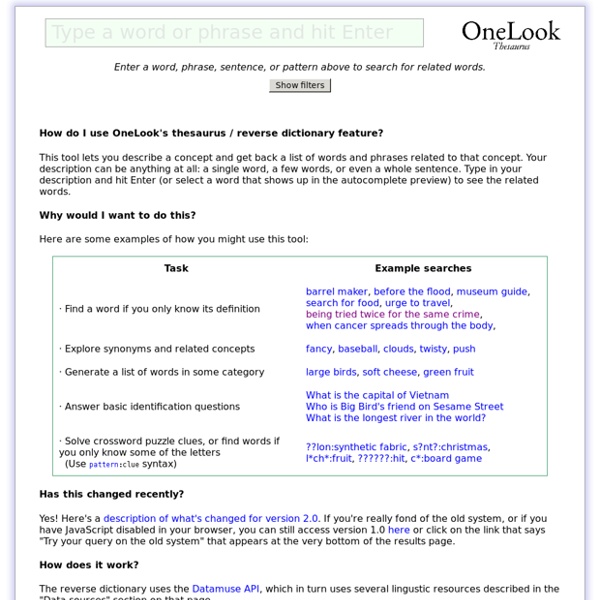Reverse Dictionary
<div id="needs_javascript"><center><b>Note: The new Reverse Dictionary requires JavaScript.</b><br /><img src="/img/a.gif?q=omg_a_user_without_js"> If you have disabled JavaScript in your browser, please <a href=" it for this site</a> or use the <a href="/? How do I use OneLook's thesaurus / reverse dictionary feature? This tool lets you describe a concept and get back a list of words and phrases related to that concept. Why would I want to do this? Here are some examples of how you might use this tool: Has this changed recently? Yes! How does it work? The reverse dictionary uses the Datamuse API, which in turn uses several lingustic resources described in the "Data sources" section on that page. Yikes. For some types of searches only the first result or the first few results are likely to be useful. If you get back nothing but junk, try restating your query so that it's just two or three simple words. Can I use this service from anywhere on OneLook?
Related: More Resources
American Heritage Dictionary - Search
expresses solidarity with Japan as fire rips through World Heritage site in Okinawa
UNESCO offers its sincere solidarity with the people of Japan, and in particular the residents of Okinawa, who have lost a cultural and historical symbol of the Ryukyu islands. UNESCO stands ready to assist the authorities as needed. In the early morning hours of 31 October, a number of buildings, including Shuri Castle of the World Heritage site of “Gusuku Sites and Related Properties of the Kingdom of Ryukyu” (Japan) were damaged by a large fire. Damaged buildings, including three main halls, were reconstructed after World War II, as they were previously destroyed during the war. This work was based on detailed documentation of the original and was noted in the World Heritage inscription as respecting the authenticity. This UNESCO World Heritage site represents 500 years of Ryukyuan history (12th-17th century) in a group of sites and monuments.
Body Language: An Artistic Writing Tool | Writers In The Storm Blog
By Sharla Rae Have you ever people-watched and tried to guess by facial expressions and body movements what people are feeling or thinking? This non-verbal communication of emotion, state of mind or state of physical well-being is known as body language. Body Language is one of the most artistic and useful tools in the writing craft. The art: Writers paint word visuals of a character’s movements in the reader’s mind and this art is crucial in making our characters look and act like real people rather than stick characters moving around on the page. The tools: I demonstrated how to use body language as a tool to eliminate clunky saidisms in my blog, “Dialogue Tags: How To Kill Some Of The Little Buggers,– showing who’s speaking rather than telling. Body language may also be used to set the tone or atmosphere in a scene. Body language includes facial expressions. One of my fav TV series is Lie To Me. The key to great body language is simple. Joe walked/ran across the street. Head Movement Nose
Thesaurus.com | Find Synonyms and Antonyms of Words at Thesaurus.com
Master List of Color Names and Color Descriptions
This is a list of color names as well as color descriptions that relate to specific objects. Sometimes I think of a list I wished I had included in my book Master Lists for Writers, so I put it here! I’ve tried to list the more familiar or clichéd descriptions first and then the fresher descriptions, though I haven’t tried to get it in perfect cliché-to-fresh order. Characters may still use clichés when they are speaking — sometimes, that’s just realistic dialogue. Some of these suggest other qualities in addition to color, such as texture. Just adding a more specific word can make a description more striking. Some of the more common color descriptions and phrases are actually outdated and/or a bit weird. Color descriptions can even evoke the worldview of a character in a fantasy, science fiction, or historical novel, such as “white as the robe of a priestess” or “black as a model T Ford.” I may add more to this later! raven ebony obsidian onyx sable black as coal pitch black jet black crow-black
Longman Dictionary of Contemporary English- 6th Ed on the App Store
UNESCO World Heritage Sites in Japan | Japan Travel Guide
Japan, known as the endless discovery country for travelers, live up to its tagline with 17 UNESCO World Heritage Sites pack into this relatively small size. The sites range from historical to nature and to cultural. Truly pack with all the wonders of the world from natural to man-made, you can be sure to be to be wow by the many tourist attractions here. If you are those who want to tick off the list of world heritage sites, Japan is one of the best places to start. Japan UNESCO World Heritage Sites MapClick on for larger map Here is the list of Japan’s UNESCO World Heritage Sites: Japan’s Cultural Heritage Sites Buddhist Monuments in the Horyu-ji Area One of the National Treasure of Japan, this area includes a variety of buildings found in Horyu-ji and Hokki-ji in Ikaruga, Nara Prefecture, Japan. Japan UNESCO World Heritage Site: Horyu-ji Fujisan, sacred place and source of artist inspiration Japan UNESCO World Heritage Site: Fujisan Japan UNESCO World Heritage Site: Gusuku Sites Himeji-jo
Onomatopoeia Dictionary - Written Sound
Names - Meaning of Names
Wikisource, the free library
Wolfram Words Reference App on the App Store
Related:



